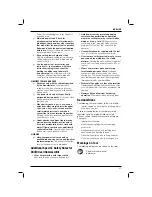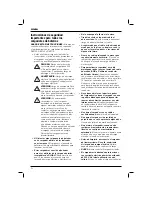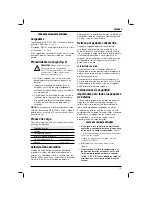
ENGLISH
40
SPECIFIC SAFETY INSTRUCTIONS FOR NICKEL CADMIUM
(NiCd) OR NICKEL METAL HYDRIDE (NiMH)
• Do not incinerate the battery pack even if it
is severely damaged or is completely worn
out.
The battery pack can explode in a fire.
• A small leakage of liquid from the battery
pack cells may occur under extreme usage
or temperature conditions
.
This does not
indicate a failure.
However, if the outer seal is broken:
a.
and the battery liquid gets on your skin,
immediately wash with soap and water for
several minutes.
b.
and the battery liquid gets into your eyes,
flush them with clean water for a minimum
of 10 minutes and seek immediate medical
attention. (
Medical note:
The liquid is
25-35% solution of potassium hydroxide.)
SPECIFIC SAFETY INSTRUCTIONS FOR LITHIUM ION
(Li-Ion)
• Do not incinerate the battery pack even if it
is severely damaged or is completely worn
out.
The battery pack can explode in a fire.
Toxic fumes and materials are created when
lithium ion battery packs are burned.
• If battery contents come into contact with
the skin, immediately wash area with mild
soap and water.
If battery liquid gets into the
eye, rinse water over the open eye for
15 minutes or until irritation ceases. If medical
attention is needed, the battery electrolyte
is composed of a mixture of liquid organic
carbonates and lithium salts.
• Contents of opened battery cells may cause
respiratory irritation.
Provide fresh air. If
symptoms persists, seek medical attention.
WARNING:
Burn hazard. Battery liquid
may be flammable if exposed to spark
or flame.
Battery Cap (fi g. 3)
A protective battery cap is supplied to cover the
contacts of a detached battery pack. Without the
protective cap in place, loose metal objects could
short circuit the contacts, causing a fire hazard and
damaging the battery pack.
1. Take off the protective battery cap before
placing the battery pack in the charger
or tool (Fig. 3A).
2. Place the protective cap over the contacts
immediately after removing the battery pack
from the charger or tool (Fig. 3B).
WARNING:
Make sure the protective
battery cap is in place before storing or
carrying a detached battery pack.
Battery Pack
BATTERY TYPE
The DC720, DC721, DC722, DC725 and DC727
operate on 18 volt battery packs.
The DC730, DC731, DC732, DC735 and DC737
operate on 14,4 volt battery packs.
The DC742, DC743 and DC745 operate on 12 volt
battery packs.
Storage Recommendations
1. The best storage place is one that is cool and
dry away from direct sunlight and excess heat
or cold. For optimum battery performance and
life, store battery packs at room temperature
when not in use.
NOTE:
Li-Ion battery packs should be fully
charged when stored.
2. Long storage will not harm the battery pack or
charger. Under proper conditions, they can be
stored for up to 5 years.
Labels on Charger and Battery Pack
In addition to the pictographs used in this manual,
the labels on the charger and the battery pack show
the following pictographs:
Read instruction manual
before use.
Battery charging
Battery charged
Battery defective
Hot/cold pack delay
Do not probe with conductive objects.
Do not charge damaged battery packs
Use only with D
E
WALT battery packs,
others may burst, causing personal injury
and damage.
Содержание DC720
Страница 1: ...DC720 DC721 DC722 DC725 DC727 DC730 DC731 DC732 DC735 DC737 DC742 DC743 DC745 www eu ...
Страница 3: ...1 a b c d f e Figure 1 Figure 2 Figure 3 A B g h g h j i ...
Страница 4: ...2 Figure 4 Figure 7 Figure 6 c c c Figure 5 k i ...
Страница 202: ...200 ...
Страница 203: ...201 ...
















































